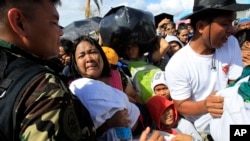MANILA —
The Philippine government is racing to bring food and water to some communities that have seen little aid six days after a punishing super typhoon battered the central islands. The Civil Defense Office has confirmed more than 2,300 deaths so far.
United Nations Undersecretary-general Valerie Amos said Thursday the situation in the Philippines is dismal and U.N. organizations are focused on speeding aid to those in need.
"I think we are all extremely distressed that this is day six and we have not managed to reach everyone," Amos said.
Source: UN
According to the United Nations, 673,000 people have been left homeless by the storm. After visiting the hard-hit city of Tacloban Wednesday, Amos said there are signs that air operations are scaling up.
Tacloban, the capital of Leyte province, has been a focus of aid efforts, as one of the largest and hardest hit cities in the devastated central Philippines. But there are many communities in more rural areas that were also hard hit.
Presidential Spokesman Sonny Coloma told reporters Thursday authorities are making progress clearing roads and sending aid convoys to these smaller towns.
They are on the ground, he said, and that is why they have projected that reasonably by Thursday this aid will arrive in 100 percent of the 40 municipalities in that part of Leyte.
To speed things up, several government buildings in the capital, Manila, have been turned into packing centers for food aid. But the struggle has been more with delivering aid than procuring it.
Typhoon Haiyan cut a very straight path across the northern half of Leyte province, and Tacloban took the brunt of its massive storm surge.
Early on, the idea was to fly aid to Tacloban airport and then distribute it to further out locations. But the airport remains overwhelmed with the needs of survivors in a city where some 70 percent of the 220,000 residents were made homeless. Aid deliveries have struggled to travel far, as hungry citizens stop trucks and demand food.
But, says Southern Leyte Vice Governor Mike Maamo, the bottom half of Leyte province suffered no casualties.
The governor plans to bring 150 security personnel from his region to Tacloban on Friday to help protect food deliveries from looters. He called on nearby communities that also avoided the worst of the storm to help in the aid effort.
“It is but necessary now that those other provinces should support and coordinate and help the municipalities and the city of Tacloban as far as the distribution is concerned,” he said.
Maamo says almost 100 percent of the local responders in Tacloban have not been able to help because they too were affected by the storm.
Maamo, who is on the provincial disaster management council, says the group is starting an “adopt a municipality” program for the far flung towns.
But while some Philippine officials expressed optimism that aid would soon begin flowing to communities, outside aid agencies Thursday were continuing to assess communication, transportation and safety concerns for future aid deliveries.
United Nations Undersecretary-general Valerie Amos said Thursday the situation in the Philippines is dismal and U.N. organizations are focused on speeding aid to those in need.
"I think we are all extremely distressed that this is day six and we have not managed to reach everyone," Amos said.
Super Typhoon Haiyan
Super Typhoon Haiyan- 10,000 people feared dead
- At least 9.8 million people affected
- About 660,000 people displaced
- 394,494 people are in evacuation centers
- 1,316 evacuation centers have been established
Source: UN
Tacloban, the capital of Leyte province, has been a focus of aid efforts, as one of the largest and hardest hit cities in the devastated central Philippines. But there are many communities in more rural areas that were also hard hit.
Presidential Spokesman Sonny Coloma told reporters Thursday authorities are making progress clearing roads and sending aid convoys to these smaller towns.
They are on the ground, he said, and that is why they have projected that reasonably by Thursday this aid will arrive in 100 percent of the 40 municipalities in that part of Leyte.
To speed things up, several government buildings in the capital, Manila, have been turned into packing centers for food aid. But the struggle has been more with delivering aid than procuring it.
Typhoon Haiyan cut a very straight path across the northern half of Leyte province, and Tacloban took the brunt of its massive storm surge.
Early on, the idea was to fly aid to Tacloban airport and then distribute it to further out locations. But the airport remains overwhelmed with the needs of survivors in a city where some 70 percent of the 220,000 residents were made homeless. Aid deliveries have struggled to travel far, as hungry citizens stop trucks and demand food.
But, says Southern Leyte Vice Governor Mike Maamo, the bottom half of Leyte province suffered no casualties.
Some Organizations Helping Typhoon Victims
Some Organizations Helping Typhoon Victims“It is but necessary now that those other provinces should support and coordinate and help the municipalities and the city of Tacloban as far as the distribution is concerned,” he said.
Maamo says almost 100 percent of the local responders in Tacloban have not been able to help because they too were affected by the storm.
Maamo, who is on the provincial disaster management council, says the group is starting an “adopt a municipality” program for the far flung towns.
But while some Philippine officials expressed optimism that aid would soon begin flowing to communities, outside aid agencies Thursday were continuing to assess communication, transportation and safety concerns for future aid deliveries.










